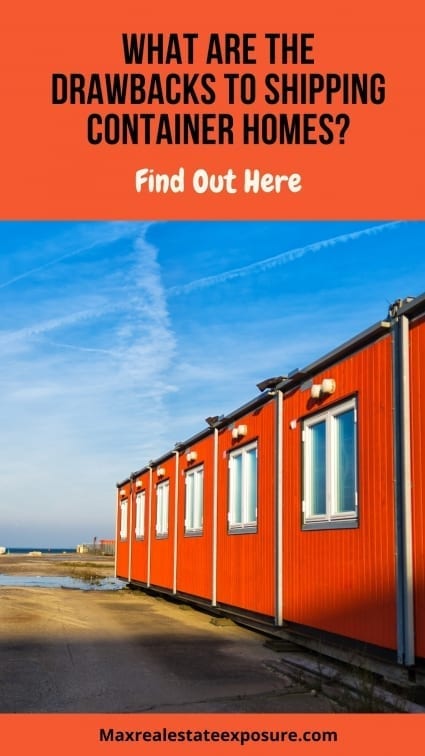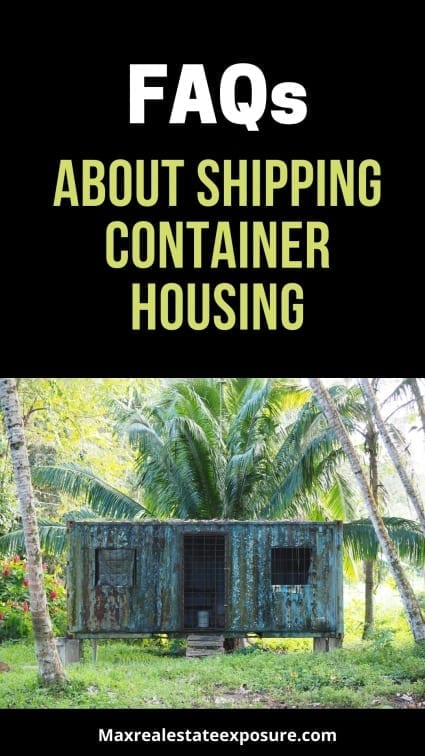The Guide to Container Housing
 Are you considering a shipping container home? Using a shipping container as a home doesn’t sound plausible, but it is.
Are you considering a shipping container home? Using a shipping container as a home doesn’t sound plausible, but it is.
Shipping container homes are one of the latest trends in housing choices.
Shipping containers transport goods worldwide and are strong enough to withstand being moved on ships and trucks. But do they also make good homes?
With many options, they present an opportunity to create eco-friendly homes.
A home can be created from a single box, or multiple shipping containers can form more significant buildings with several floors.
Shipping container houses are also called storage container homes or containerized homes.
When most people think about storage containers, it is usually of the moving and storage variety, such as PODS.
They are rapidly increasing in popularity, and you’ll undoubtedly be hearing more about them in the future.
Shipping containers can make homes, cabins, dormitories, apartments, and offices.
Can you imagine using a used shipping container to build an apartment building, backyard office, or large building? Well, it is happening!
Using a shipping container as a home presents an opportunity for those with a limited budget. They are a compact, cost-effective, minimalist-designed property perfect for off-grid housing.
Let’s look at what you can do with containers to create a perfect home for you and its costs. By the time you’re done reading, you’ll have everything you need to know about using shipping containers as homes.
What Do These Homes Offer?
Lots of folks ask what a shipping container home is. There are two standard sizes of shipping containers: 40 by 8 feet, providing 320 square feet, and 20 by 8 feet, giving you 160 square feet of space.
They are usually 8 and 1/2 feet high, though a slightly taller version is available.
The taller version is known as High Cube Containers. If you can get one, high cubes are the preferred choice for shipping container homes. They are an additional foot taller, which makes insulating them much more manageable.
A High Cube is about fifty percent more expensive but well worth it. The extra foot-in ceiling height makes a big difference!
Homes can be made up of just one of these structures. It could be the ideal size for an office or a small house. However, often, they are combined to produce a much larger living space.
When multiple shipping containers are put together, sometimes the walls are removed between them. This creates an ample open space that is more suitable for modern living. These shipping container homes are then finished using traditional construction methods to make interior walls.
They are designed to be stackable, so multiple repurposed units can be used to create a multi-level residence. Some architects have embraced the construction to create a very different home that doesn’t hide that it’s made from metal boxes.
Building materials used in traditional homes are combined to enhance the overall appeal of the container architecture.
What About Prefab Container Residences?
Prefab container homes are built in a factory setting. They are made to conform to local building codes wherever they are placed.
The local building code can differ from state to state and even some nuances from one city or town to the next. Building them in a factory makes them not open to the environment during construction.
New shipping boxes are typically used in prefab construction vs. used containers. You can customize your container architecture to include all the bells and whistles you’re looking for, including large windows to flood the home with natural light, a spacious living room, a lavish master suite, and maybe a roof deck.
The possibilities for customizing your home with a modular design are endless. This might be the perfect option if you are looking for a new home. Affordable homes are available and compare nicely with tiny houses.
This housing choice makes affordable custom living possible, with lower construction costs than a traditional home.
The History of Using Containers as Housing
You may be wondering how these homes came about. Phillip Clark filed a patent in November of 1987 called the method of converting steel shipping containers into a habitable building.
In his patent, Clark cited how they could be put on weight-bearing foundations to create housing. The patent took two years to be granted. In August of 1989, he was awarded patent #US4854094A.
It was not until the mid-2000s that using a shipping container for a home became more commonplace, with architects drawing up designs for a more economical housing choice.
Since that time, they have continued to grow in popularity.
How to Buy Them?
 It is possible to buy a brand-new shipping container to create a home. Perhaps unsurprisingly, most are manufactured in China, where many steel manufacturers produce the required metal.
It is possible to buy a brand-new shipping container to create a home. Perhaps unsurprisingly, most are manufactured in China, where many steel manufacturers produce the required metal.
However, the United States has national and local sellers of used metal boxes.
However, you must be aware that not all of them are identical. The containers are certified for different uses, with some offering protection from wind and water.
Others are only constructed for single transportation and will be available for sale from used dealers. These single-trip or one-trip metal boxes are generally in good condition and offer better value.
As you might expect, new units are in good shape and preferred over old ones.
They can be bought in an “as is” condition, which could mean the container has some damage.
There could be rust, doors that don’t close properly, or even holes.
There is also a risk of contamination from chemical spills within them. Buying an “as is” container is not advisable if you want to use it to construct a place to live.
A national container company will supply most locations, but you may find that a local supplier offers better value for money.
It would help to remember that the smaller 40-ft containers could be moved more quickly. They can often be towed, whereas the larger 40-foot units must be brought by semi-truck and craned into position.
The small units can usually be positioned by forklifts, reducing the overall cost of your shipping container. There are dealers you can purchase from online.
A quick Google search for a container dealer will lead you to them. Check the point of origin and know precisely what you’re getting.
Examples of Them As Houses
You can even buy an already-created home. Many companies provide this service, allowing you to choose what you want from your home.
Curbed has some great examples of shipping container homes that will be worth a look at. You can order these residences online.
The Curbed website offers some excellent photos of the houses, along with their specifications.
Believe it or not, you can even order a shipping container home from Amazon. Their container home costs $36,000.
Frankly, it is not that attractive looking. It is as basic as it gets for the exterior look.
Look Inside These Homes
There are indeed some fantastic home designs. If you want to be blown away, look at some of the incredible offerings of shipping container properties worldwide at House Beautiful.
If you want to look inside these properties, you can do so at their site.
They showcase 23 different examples of container houses. You will see a beautiful gallery of housing in this resource. If you think of getting a container home, the site will give you some great ideas.
You’ll likely be blown away when you look inside these homes. Most people don’t expect them to be so lovely.
You will even see luxury home designs, which are just incredible.
Are These Houses a Cheaper Option?
These houses can be cheaper than a traditional home, but this isn’t always true. Many things can affect the cost of your property. The build size, design choices, and finish quality are factors, and a location can increase the price.
You need to own the lot for your new home, though you can save money preparing the ground. They don’t need the same foundation as ordinary homes, allowing them to be constructed on more challenging terrain.
They can be built on a rocky or steep site without excavating the land. Piling could support the home, saving on expensive site preparation.
This could allow you to save money on purchasing a plot of land. While other people will have been put off because of the cost of excavation, this won’t be such a problem with a shipping container.
You have to ensure that local zoning allows for that type of build.
If you have your heart set on this housing, having a contingency in your land purchase contract will make sense before moving forward. You can remove the contingency once you have completed your due diligence on the zoning.
What Does an Individual Container Cost?
 Smaller units can cost as little as $1,500. A brand new 40-ft container could cost you over $6,000, however.
Smaller units can cost as little as $1,500. A brand new 40-ft container could cost you over $6,000, however.
It would help if you remembered this has additional costs, including transportation, container positioning, and crane hire.
The housing can have a wide range of pricing depending on what you do with them.
The final product will be much more than the initial cost of buying the container.
How Much Do The Houses Cost?
One of the more popular questions people research is how much shipping container homes cost.
For a small basic home, you can expect to pay anywhere between $15,000 to $50,000.
Larger houses with multiple adjoining containers and amenities can easily approach over $100,000 and head over $200,000 for something more luxurious.
Compared to traditional housing, these properties can quickly come in for half the price, making this housing choice very attractive.
Many factors can contribute to the cost of these houses.
Some of the factors that can influence the final cost include the following:
- Size, design, and layout of the house.
- Cleaning costs when buying a used container.
- Welding requirements of the project.
- Plumbing and electrical requirements.
- Flooring used.
- How is it insulated?
- Siding choices
- The type of kitchen and baths installed
- The type of windows and doors used.
How Quickly Are The Homes Built?
Since you are starting with a structure, this typically saves some time over traditional home construction. Making a small house habitable can take just a few weeks.
However, your specifications for the property and the project’s complexity can lead to a construction of this sort taking a few months.
You can still face contractor delays as you would with a traditional home. You can reduce possible delays and speed up the project by buying your container from a company that does much of the work for you.
These prefab shipping containers will cost you more to purchase initially but will save you time during construction. They can sell them ready to move into, leaving you to add the finishing touches in your own time.
The situation would be similar to a modular home, with a significant portion of the construction done in a factory setting and then shipping elsewhere for the finishing touches. They share these characteristics.
With this type of construction, you could hire separate contractors to add special touches at your leisure.
You can have exactly what you’re looking for with innovative architects and the right contractor. Simple designs, of course, bring lower costs, while more elaborate designs bring higher prices.
As mentioned, the cost will depend on all the goodies you add.
Check Your Local Laws With This Housing Choice
Before you begin ordering, you need to know the rules for your location. Will a shipping container for a house meet the zoning requirements and building code?
The building code in your area might state that these homes can be constructed. They are often considered a non-traditional structure, and you must follow the rules for those types of buildings.
Generally, if you are in a more remote area, you will have fewer problems with restrictions. Ensure you check with the relevant authorities to avoid violating the rules. It will also be highly advisable to see the units you plan on buying.
Many folks who have bought them recommend finding a contractor to complete the whole process, including modifying them and finishing the interior.
What States Allow Shipping Container Homes?
Are there states where using a shipping container as a home is looked at more favorably? There sure are! As mentioned, rural and suburban areas tend to be more open to allowing them.
Some states, in particular, are more alternate housing friendly than others.
You will find that Texas, Missouri, Louisiana, California, Alaska, Tennessee, and Oregon are among the states that have been more receptive to having these homes.
There is already an abundance of this housing in Texas. Louisiana and Tennessee are well-known for having some of the laxest zoning regulations in the US. Surprisingly, California has been receptive to the container home concept.
As more affordable housing options expand, other states will likely become more receptive to using them as houses in certain areas.
The key will be checking on getting a building permit, as mentioned.
Is Building Container Housing Eco-Friendly?
Since buying a new unit is frequently cheaper than returning it to be used again, many only get used once. There are many discarded shipping containers globally, so recycling these into houses must be good, right?
Using a steel unit reduces the other materials you need to build a home. Often, owners of such a home also add other Eco-friendly measures, like solar panels or wind power.
But the case for them being sustainable homes isn’t quite as clear-cut.
It is argued that many resources and energy are needed to turn the container into a home. Hazardous waste can be produced when converting the structure; some units are worse than others.
If they’ve been used to carry toxic chemicals, a residue that needs to be dealt with might remain.
They may also have been treated for corrosion at some point, which can be another problem. You need to make sure you buy a suitable one in the first place to avoid these issues.
Can These Houses Have Roofs Added?
Many builders will add a roof constructed of another material rather than keeping them intact. This is often done for architectural flair and increased visible desirability.
There are a few different types of roof structures you will find with the homes, including:
- Traditional pitched roofs – the most common roof in traditional housing is a pitched roof. This roof type tends to be the most visually appealing to most people. You can see pitched roofs occasionally being added to them.
- Green roofs – one of the more pleasing roofs is the “living roof,” filled with plants and other greenery. This type of roofing allows for natural insulation properties.
- Flat roofs – a flat roofing structure is the most cost-effective and straightforward to build and the least visually appealing. There will be a slight pitch added so that the roof drains properly.
Some excellent container housing will also be constructed to have a roof deck.
Are There Any Downsides to Owning a Container Home?
 Do you know the cons of this housing? One of their advantages is that they are easy to move, but this is also a downside.
Do you know the cons of this housing? One of their advantages is that they are easy to move, but this is also a downside.
With the internal dimensions only just over 7 feet wide, this restriction could put off many people.
There are ways around this problem, like putting two together and removing the walls or using some to enclose an area and then building a roof between them.
Whatever alterations you make, the home will continue to look like a metal box most of the time.
For many, this won’t be a problem, however, as they like the industrial look of the property.
You can do a lot to improve the home’s exterior design, with cladding and upgrades to increase space. It will, though, almost inevitably, put off some buyers when you come to sell the home.
With shipping containers, it is more of a challenge to install insulation. The corrugated steel walls differ from standard walls with room for cavity insulation.
The structure needs significant reinforcement if you use many containers with multiple floors.
Such engineering challenges will add significantly to the cost of a project like this. They do hold a place in the housing market. They are a cheaper housing choice when you own a piece of land.
Shipping container houses could be compared to the tiny home phenomena that have become more popular in recent years. For comparison’s sake, you can see some popular tiny house designs at Country Living.
Container homes vs. tiny homes have become a debate where the pros and cons of each will be explored.
Where Can You Get Plans?
Do you want to look at floor plans? If you want to build a custom residence, you’ll probably be interested in looking at various house plans.
Since the actual flooring space will be more limited than in a traditional home, most people will opt for having a well-thought-out floor plan that maximizes the space.
Dwell has a helpful resource that shows them some excellent open floor plans. 24hplans also has some funky designs worth checking out.
There are many plans, so it is essential to do proper research. Some of the designs are amazing. They continue to get better and better. The innovation and creativity will blow you away. Dreams are becoming a reality with many of these projects.
The innovation is readily apparent in some of the customization taking place. Have a look at some of the bedrooms and bathrooms for ideas.
How to Locate Builders For These Houses?
If you are genuinely interested in building one of these residences, you’ll want to know who makes them. Dwell has an excellent resource of 16 U.S. prefab shipping container home companies.
What you will notice, however, is that some of the companies on their list have gone out of business. Nonetheless, it is still a helpful resource worth looking over.
You could also try searching online for shipping container home builders near me. If you are lucky, you’ll probably see a few more options.
Finding builders is difficult because few have gotten into this specialty housing.
How to Find Them For Sale?
Finding homes for sale will be more challenging than traditional housing as a minuscule amount is available.
You can always check with a local real estate agent to see if any are available. You could also do an online search for shipping container homes for sale, container homes for sale, or container homes near me.
Some may also look for these homes to rent, which will be equally as tricky.
Frequently Asked Questions
 Here are 15 FAQs about shipping container homes worth knowing the answers to.
Here are 15 FAQs about shipping container homes worth knowing the answers to.
Get a more in-depth understanding of this housing choice.
1. How Much Do The Houses Cost?
As mentioned, you can pick them up for a few thousand dollars. The significant expense comes when you turn it into a finished product.
It is possible to outfit a house for around $30,000.
More significant properties with multiple containers and amenities can range from $100,000 to $200,000.
However, the cost savings are genuine, as the price per square foot of traditional stick-built housing can be much higher.
They are much cheaper to build than typical houses.
2. Do I Need to See The Container Before Purchasing it?
It is highly advisable to do so. Older shipping containers could have denting, rusting, or other structural issues.
One-trip containers are more costly, but the expense is usually worth it as they are almost always in terrific shape.
One-trip units are exactly like they sound – they have made a trip from point A to point B, so they don’t have significant wear and tear.
3. Is Using a Shipping Container For Homes a Good Housing Choice?
These houses aren’t going to be for everyone. They are a much lower-cost housing alternative. The naysayers say they have little structural strength, are hard to cut and insulate and offer nothing more than cramped living quarters.
Some say they are a fad that will go out of style quickly.
4. How Long Does it Take to Construct?
It depends on the complexity of what you are doing with it. Some containers are already completely done, while others could take months to assemble.
The increase in time to build will depend on whether you have multiple units combined and the level of finishes you plan on for the interior.
5. Will You Need Permission to Have One of These Houses?
Most of the time, you must check with local zoning officials. Typically, a home is movable and not on a foundation, making it nothing more than a glorified shed regarding zoning laws in many locations.
Zoning, however, is nothing ever to take for granted. Orders in your city or town could require building permits for this type of residence.
So, living in this kind of house is legal as long as you have all the required permits and meet local zoning requirements.
If you live in a neighborhood where an HOA exists, you would need to check whether there are any restrictions for having one placed on your lot.
6. Can You Get a Mortgage For These Properties?
It depends. To get a mortgage for purchasing this kind of housing, you will generally need a piece of land where it becomes a permanent structure. This would include having a foundation and working utilities.
Without these things, a bank will not finance the purchase of them. If the property meets the guidelines, you would probably want a construction loan to finance the project.
7. Do The Homes Hold Their Value?
So far, they have. You can expect appreciation for your home. The option for transporting them to other locations makes them an appealing housing choice.
If you wonder if shipping container houses are a good investment, they should be.
8. How Are They Insulated?
You can build a studded interior wall like in traditional construction. Doing so works better when combining them for a more expansive living area. Otherwise, the cavity wall will take up additional space.
Insulating them with spray foam is also possible, although this will not give the same R-value as with Batt insulation. Quite often, builders will use insulation panels in construction.
9. Are They Toxic to Live in?
Understanding what you’re buying when purchasing is a good idea. You will need to find out what, if anything, it was previously used for.
Some containers have housed volatile or toxic materials. Residuals could be leftover from these containers that pose health hazards.
Some boxes could have been treated with paint containing harmful chemicals like chromate and phosphorus. Another consideration is radon gas seeping into the container from the ground on which it sits.
Since these houses are much more confined spaces with no basements, radon levels could be more concentrated. Ensuring you’re not living under hazardous conditions will be worth checking.
Like any other house, if there is well water, it would be advisable to check if radon exists. If so, it would make sense to remediate it.
10. Are The Containers Safe?
Yes. As long as they do not contain hazardous material as described above. Some people also ask if they are safe from lightning.
They are if the property has been appropriately grounded. A lightning rod should be added just like other homes have to help ensure your safety.
11. Are They Waterproof?
For the most part, yes. Shipping containers are manufactured to withstand the elements. They are built to be exposed to the weather while on ships transported across the United States and worldwide.
12. How Much Wind Can They Handle?
According to the rigidity test standards, a shipping container can withstand winds up to 180 miles per hour without wavering.
Shipping containers are well constructed enough to withstand a hurricane. It would help if you did not have too many worries about structural integrity from solid winds.
Shipping container houses can handle winds up to 100 miles an hour when they are on a foundation and 175 miles per hour when anchored with pylons.Click To Tweet13. Does They Rust?
It is possible. Most container houses are made of Corten steel, which is rust-resistant for the most part. If you are in an area with harsh weather conditions, it could be more susceptible to the environment.
It is a steel shipping container, after all.
Terrible weather conditions could lead to some rust. The houses that have an additional layer of siding will be much more prone not to rusting.
14. How Long Will These Houses Last?
Container homes can last decades if maintained properly. Rust is typically the issue that could take years of life out of them.
15. Can The Containers be Used For Storage Instead of Housing?
Yes. Storage containers do not have to be used just for housing. The containers have multiple uses. One such benefit is storage whether you are moving or not.
Some folks purchase a storage container instead of renting from a self-storage facility or a moving pod from a top storage company.
They can use it for their move and then have it for other uses at their next destination.
16. Have Containers Been Used For Other Housing Types Besides Homes?
Yes. Shipping containers have been used as college dormitory housing. Two dorm buildings made out of decommissioned shipping containers are in use at the College of Idaho for students on the Caldwell campus.
Interesting Facts Worth Knowing
Final Thoughts
Choosing to use shipping containers to build your next home offers many advantages. It can save time and money in the construction process, and there are prefab options to make things even more accessible.
You also recycle them, saving on the materials to build your home.
Choosing to use shipping containers isn’t without a few downsides, though. The container restricts you in a few ways, and there can be zoning issues over the placement of your home.
You need to weigh up the issues carefully before you choose this type of house construction.
Hopefully, you have found this guide to shipping container homes to help and put it to good use. By now, you should know precisely what they are and the pros and cons.
About the Author: The above Real Estate information on what to know about shipping container homes was provided by Bill Gassett, a Nationally recognized leader in his field. Bill has expertise in mortgages, financing, moving, home improvement, and general real estate.
Learn more about Bill Gassett and the publications he has been featured in. Bill can be reached via email at billgassett@remaxexec.com or by phone at 508-625-0191. Bill has helped people move in and out of Metrowest towns for the last 37+ years.
Are you thinking of selling your home? I am passionate about real estate and love sharing my marketing expertise!
I service Real Estate Sales in the following Metrowest MA towns: Ashland, Bellingham, Douglas, Framingham, Franklin, Grafton, Holliston, Hopkinton, Hopedale, Medway, Mendon, Milford, Millbury, Millville, Natick, Northborough, Northbridge, Shrewsbury, Southborough, Sutton, Wayland, Westborough, Whitinsville, Worcester, Upton, and Uxbridge MA.

